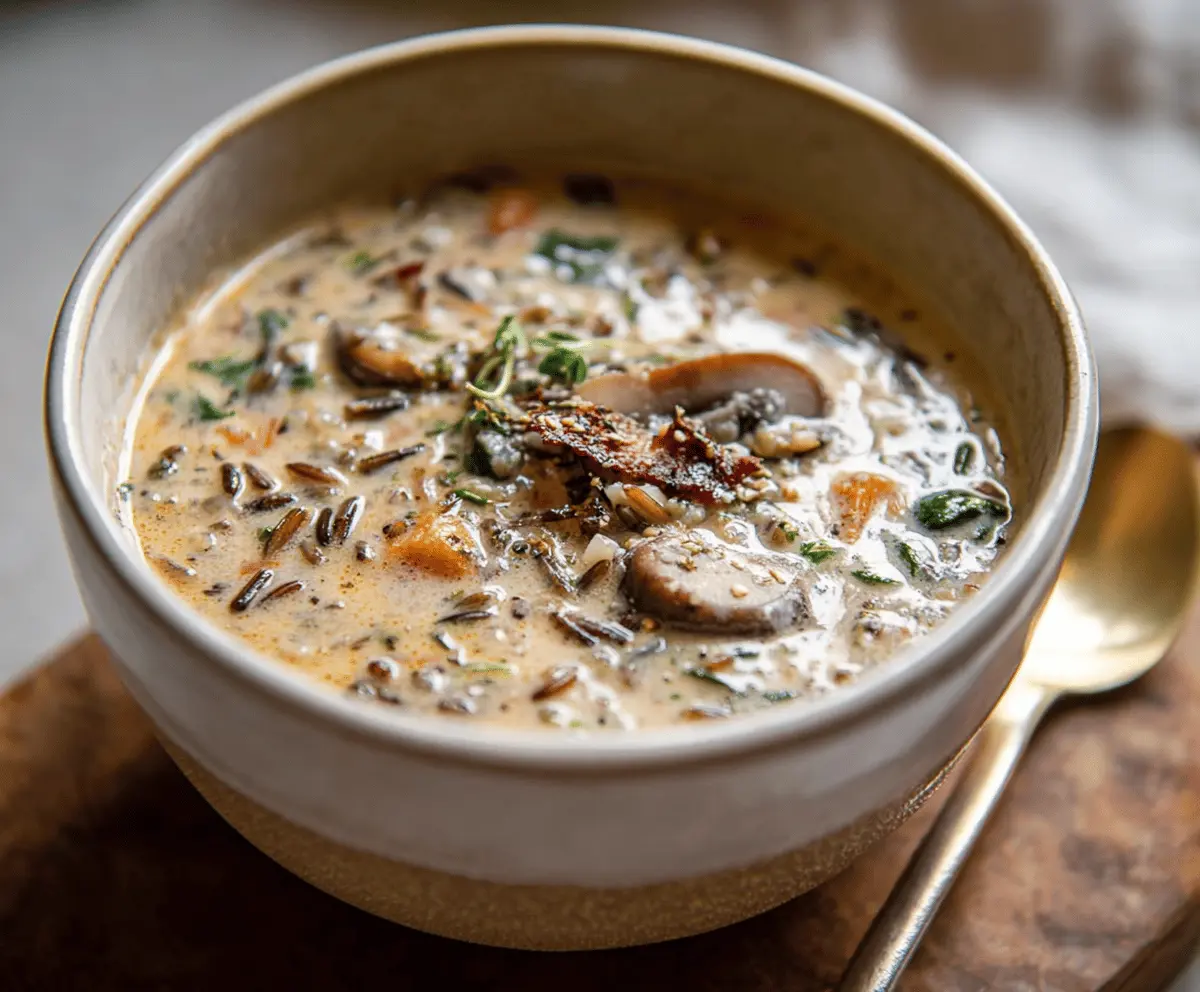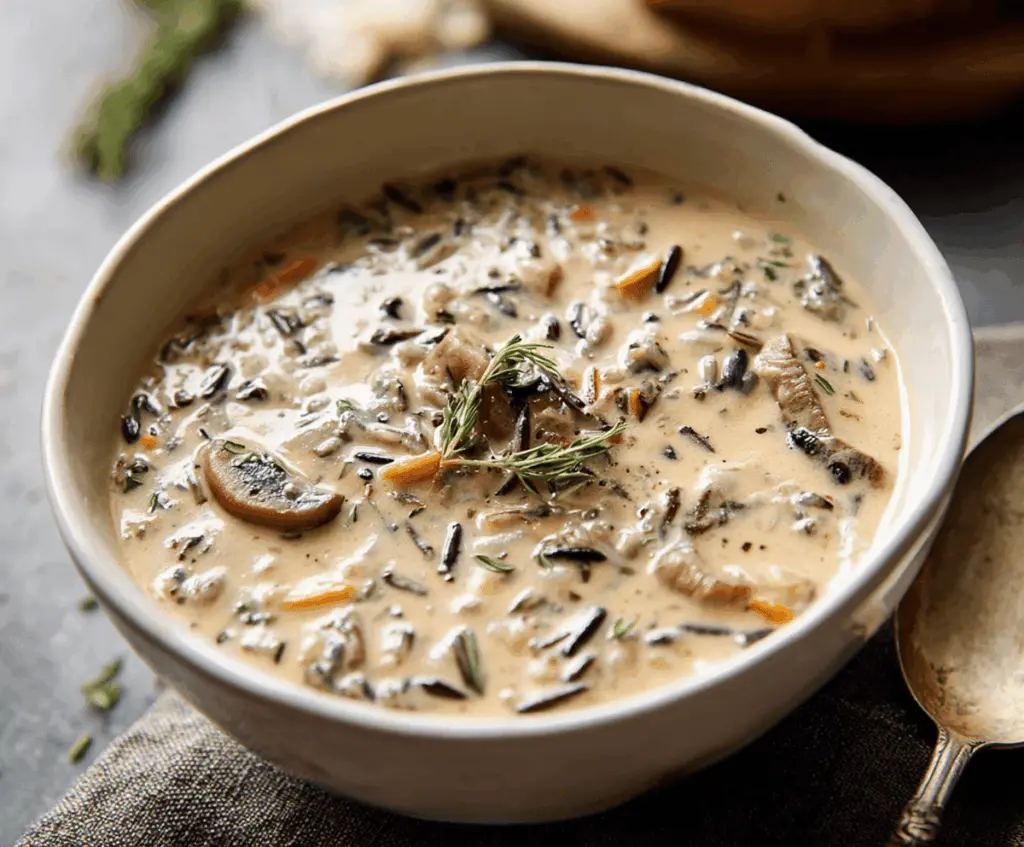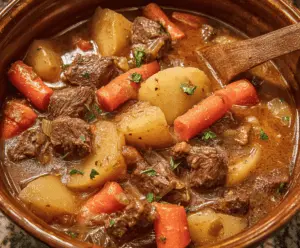Wild Rice Mushroom Soup is a hearty and comforting bowl filled with tender wild rice and earthy mushrooms swimming in a warm, flavorful broth. The chewy texture of the wild rice pairs perfectly with the soft, meaty mushrooms, making each spoonful satisfying and full of cozy goodness.
I love making this soup on chilly days when I want something that feels like a big, warm hug. It’s a simple recipe that’s easy to put together but feels a little special because of the wild rice. One tip I have is to use a mix of different mushrooms if you can — it adds so much depth to the flavor and makes the soup taste homemade in the best way.
This soup always reminds me of quiet weekends spent at home, curled up with a book and a bowl of something warm. I like to serve it with crusty bread or a side salad, turning it into a full meal that’s both tasty and cozy. It’s a great go-to whenever you want something nourishing without a lot of fuss.
Key Ingredients & Substitutions
Wild Rice Blend: This ingredient gives the soup a nutty flavor and chewy texture. You can use just wild rice or mix in brown rice or quinoa for a different bite.
Mushrooms: I like using a mix of cremini and button mushrooms for flavor depth. If you’re short on fresh mushrooms, dried porcini rehydrated in warm water works well too.
Heavy Cream: This adds creaminess without overpowering. For a lighter option, use half-and-half or coconut milk for a subtle twist.
Thyme and Bay Leaf: These herbs build warm, earthy flavors. If fresh thyme isn’t available, dried thyme works fine; just use less as it’s more concentrated.
How Do I Get the Mushrooms to Have Great Flavor without Becoming Watery?
Mushrooms can release a lot of liquid if cooked too quickly, which waters down the soup. Here’s how to avoid that:
- Heat your pan well with oil or butter before adding mushrooms. This helps them sear rather than steam.
- Cook mushrooms in batches if your pan is crowded; too many at once cause steaming.
- Let mushrooms brown nicely before stirring too often. This adds rich flavor and better texture.
- Drain any excess liquid from the mushrooms after cooking if it looks watery, then add them to the soup.

Equipment You’ll Need
- Medium saucepan – I use it to cook the wild rice, and it’s just the right size for boiling grains until tender.
- Large pot or Dutch oven – this is where you’ll sauté the vegetables and simmer the soup; it’s big enough for all the ingredients.
- Stirring spoon or spatula – helps mix everything gently without breaking up the rice or mushrooms.
- Measuring cups and spoons – for accuracy, especially when measuring liquids and herbs.
- Knife and chopping board – to prep vegetables like onions, carrots, and garlic efficiently.
- Ladle – perfect for serving the soup hot and making your bowls look neat.
Flavor Variations & Add-Ins
- Swap chicken broth for vegetable broth to make it vegetarian or vegan-friendly.
- Add a splash of sherry or white wine while sautéing the mushrooms for extra depth.
- Mix in chopped kale or spinach near the end for some extra greens and color.
- Top each serving with grated Parmesan or a sprinkle of fresh herbs for a flavor boost.
Wild Rice Mushroom Soup
Ingredients You’ll Need:
Main Ingredients:
- 1 cup wild rice blend
- 1 tablespoon olive oil or butter
- 1 medium onion, finely chopped
- 2 cloves garlic, minced
- 8 ounces mushrooms, sliced (such as cremini, button, or a mix)
- 2 medium carrots, diced
- 4 cups vegetable or chicken broth
- 1 cup water
- 1 teaspoon fresh thyme leaves (or ½ teaspoon dried thyme)
- 1 bay leaf
- ¼ teaspoon black pepper
- ½ teaspoon salt (adjust to taste)
- ½ cup heavy cream or half-and-half
- Fresh rosemary or thyme sprig, for garnish (optional)
How Much Time Will You Need?
This soup takes about 50-60 minutes from start to finish. Cooking the wild rice takes about 40-45 minutes, and preparing the soup ingredients and simmering will take around 15 minutes.
Step-by-Step Instructions:
1. Cook the Wild Rice:
First, rinse the wild rice in cold water. In a medium pot, combine the wild rice with broth and water, add the bay leaf, and bring to a boil. Reduce heat to low and cover. Let it simmer gently for about 40-45 minutes, or until the rice is tender. Drain any extra liquid if needed, then set the rice aside.
2. Sauté the Vegetables:
In a large pot or Dutch oven, heat the olive oil or butter over medium heat. Add the finely chopped onion and cook for 3-4 minutes until it becomes soft and translucent. Add the minced garlic and cook for another minute until fragrant.
3. Cook Mushrooms and Carrots:
Now add the sliced mushrooms and diced carrots. Cook for 6-8 minutes, stirring occasionally. This helps the mushrooms release their moisture and start to brown, bringing out great flavor.
4. Combine Rice and Seasonings:
Stir the cooked wild rice into the pot along with thyme leaves, salt, and black pepper. Pour in more broth (about 1-2 cups) if you want a thinner soup. Bring everything to a gentle simmer.
5. Add Cream and Finish Cooking:
Stir in the heavy cream or half-and-half and cook for an additional 5 minutes. Be careful not to let the soup boil now; you want it to thicken gently and allow the flavors to blend.
6. Final Touches and Serving:
Remove the bay leaf, taste, and adjust seasoning as needed. Ladle the soup into bowls and garnish with a small rosemary or thyme sprig if you like. Serve warm with crusty bread or a fresh green salad for a cozy meal.
Can I Use Dried Wild Rice Instead of a Wild Rice Blend?
Yes! Just keep in mind that dried wild rice alone may take a bit longer to cook (about 45-50 minutes). Follow the package instructions and adjust the cooking time accordingly.
Can I Substitute Heavy Cream with a Dairy-Free Alternative?
Absolutely! Coconut milk or cashew cream are great dairy-free options that will still give your soup a creamy texture and rich flavor.
How Do I Store Leftover Wild Rice Mushroom Soup?
Store leftovers in an airtight container in the fridge for up to 3 days. Reheat gently on the stovetop over low heat, stirring occasionally to keep it smooth.
Can I Freeze This Soup?
Yes, you can! Freeze the soup in portioned containers for up to 2 months. Thaw overnight in the fridge, then reheat gently. Note that the texture of the cream might change slightly after freezing, so stir well when reheating.



